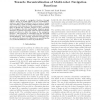Free Online Productivity Tools
i2Speak
i2Symbol
i2OCR
iTex2Img
iWeb2Print
iWeb2Shot
i2Type
iPdf2Split
iPdf2Merge
i2Bopomofo
i2Arabic
i2Style
i2Image
i2PDF
iLatex2Rtf
Sci2ools
ICRA
2005
IEEE
2005
IEEE
Towards Decentralization of Multi-robot Navigation Functions
—We present a navigation function through which a group of mobile agents can be coordinated to achieve a particular formation, both in terms of shape and orientation, while avoiding collisions between themselves and with obstacles in the environment. Convergence is global and complete, subject to the constraints of the navigation function methodology. Algebraic graph theoretic properties associated with the interconnection graph are shown to affect the shape of the navigation function. The approach is centralized but the potential function is constructed in a way that facilitates complete decentralization. The strategy presented will also serve as a point of reference and comparison in quantifying the cost of decentralization in terms of performance.
Graph Theoretic Properties | ICRA 2005 | Navigation Function | Navigation Function Methodology | Robotics |
| Added | 25 Jun 2010 |
| Updated | 25 Jun 2010 |
| Type | Conference |
| Year | 2005 |
| Where | ICRA |
| Authors | Herbert G. Tanner, Amit Kumar |
Comments (0)

